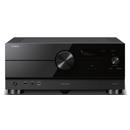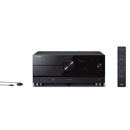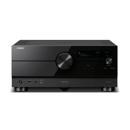
Yamaha A-S1100 Integrated Amplifier and Receiver, Black/Piano Black
SKU: YAAS1100BL
This item is no longer available.
Recommended Alternatives
Share:
Overview
Compare
Specs
Q&A
Questions & Answers
Reviews about this item
Review Summary
2019-12-09T19:00:00
Rated 5 out of 5
Nice amp that does not interject itself
I use this amp with KEF LS50's. Although they are said to be relatively inefficient, the amp has not gotten more than mildly warm at any time. The channel separation and frequency balance is excellent. This amp does not get "in your face", nor is it dark. I guess amps are subjective like all other components, but this unit seems stoutly made and I have not experienced any issues thus far. Like others have commented, the only glaring deficiency is the absence of an LED on the volume knob to make you aware of the volume setting from across the room. You have to be careful or this can lead to some surprises, as the volume control cannot be set to a preset volume at every turn on-it is wherever you left it. It is a really nice looking amp (mine is black).
Dennis
Originally posted at

2018-06-10T13:51:06
Rated 5 out of 5
Amazing!
I did a lot of research before buying this integrated amp. Love it. Great quality. Sounds fantastic. Love the look.
Van H.
2017-09-24T20:00:00
Rated 5 out of 5
Great amp that requires some break-in
Over the last year, I've tried numerous amps that retail under $3K, and finally settled on the A-S1100. For someone who doesn't require a top-shelf headphone amp or XLR inputs, I think this is the best value in the Yamaha line. The only other difference I'm aware of between the 1100 and 2100 is the capacitance spec, but the 1100 still touts 72,000 microfarads of filter capacitance, which is almost twice that of many similarly priced integrateds. This amp initially sounds unrefined and needs many hours of break-in to sound best. If you're used to Yamaha's entry level bi-polar transistor based integrateds, this amp will sound bright at first, but give it a good 50 hours of use and it levels out. My A-S1100 now emulates the sound of tubes more than any other solid state integrated I've heard, which includes some tube/SS hybrids such as the Rogue Audio Pharaoh. Though it's a class AB amp, this Yamaha runs warm and will go pound for pound against some integrateds that operate in high-bias class A. This amp is built like a tank and well thought out. Everything exudes quality. For example, the heatsinks have microridges on each fin for extra surface area. That's attention to detail that you just won't find in other amps of this class. For reference, some other amps I've owned or auditioned are the Sony TA-A1ES, Parasound Halo Integrated, various Integra AVRs, a $30k Devialet, and the Rogue Audio Sphinx, Pharoah and Cronus Magnum. IMO, the A-S1100 meets or exceeds the performance of all of these. It also has the best on-board phono stage of this bunch. Gripes? I wish it had an LED or something similar on the volume knob. The recessed notch is not visible in low light. I also wish they included the loudness compensation control found in their lower priced amps. Finally, the packaging leaves some to be desired. It managed to survive its initial journey to my doorstep, but I wouldn't be comfortable shipping it in only the factory box.
Rollo
Originally posted at

2017-03-04T19:00:00
Rated 4 out of 5
Quality product, a few issues
I had the S801 and loved it, great sound but wanted to upgrade. To tell the truth this unit sounds great too but I could not tell the difference between this and the 801. Obviously my speakers could be the limiting factor but they are high quality and the source is an Oppo 105 so I think if there was a significant improvement I would have heard it. Also, the gain on the volume control is way off, just a single input greatly increases or decreases the volume. The remote will not penetrate the glass doors on my cabinet, a problem I don't have with any other component. So it's a beautifully made high quality two channel piece of audio equipment, but if I were doing it again I'd keep the S801 and save the money.
orthodoc
Originally posted at

2016-04-06T20:00:00
Rated 5 out of 5
Incredible Performance From Yamaha
I have listened to some really fantastic audio gear. Had a vintage Mcintosh setup, Line Magnetic setup, and a very nice Classe Cap-2100 integrated, this piece on balance is the best I have ever heard. The phono stage is also really excellent, and would easily spend $1k on the current market to better it. It drives my speaker with wonderful ease, and gives a very lyrical quality to music. It is not, however, a rosy hued gloss for your music; but I think even bad recordings benefit from its ability to deliver very pure natural tones. It is very close in performance to some very expensive setups I have heard, and I think on balance, you would have to have to spend crazy amounts of discretionary income to seek better performance. Oh, and aesthetics are important to me, so well done on the physical design/build quality. It is fantastic.
Seatown n.
Originally posted at

Yamaha A-S1100 Specifications
Rated Output Power
At 8 Ohms: 180 W RMS (90 W per channel, 20 Hz to 20 kHz, 0.07% THD)
At 4 Ohms: 300 W RMS (150 W per channel, 20 Hz to 20 kHz, 0.07% THD)High Dynamic Power per Channel
8 Ohms: 105 W
6 Ohms: 135 W
4 Ohms: 190 W
2 Ohms: 220 WDamping Factor
250 (8 ohms, 1 kHz)
Frequency Response
5 Hz to 100 kHz (+0 dB / -3 dB)
RIAA Equalization Deviation
20 Hz to 20 kHz (+/-0.5 dB)
Total Harmonic Distortion (THD)
CD to Speaker Output: 0.025% (20 Hz to 20 kHz)
Signal-to-Noise Ratio
CD: 100 dB (S: 200 mV)
Input Sensitivity
CD: 200 mV / 47 k ohms
Dimensions (W x H x D)
17.13 x 6.13 x 18.25" / 43.51 x 15.57 x 46.36cm
Weight
51.4lbs / 23.31kg
UPC Code
027108950556
About Yamaha A-S1100
FEATURED REVIEWS
Incredible Performance From Yamaha
By Seatown n.
I have listened to some really fantastic audio gear. Had a vintage Mcintosh setup, Line Magnetic setup, and a very nice Classe Cap-2100 integrated, this piece on balance is the best I have ever heard. The phono stage is also really excellent, and would easily spend $1k on the current market to better it. It drives my speaker with wonderful ease, and gives a very lyrical quality to music. It is not, however, a rosy hued gloss for your music; but I think even bad recordings benefit from its ab...
View full Review
Great amp that requires some break-in
By Rollo
Over the last year, I've tried numerous amps that retail under $3K, and finally settled on the A-S1100. For someone who doesn't require a top-shelf headphone amp or XLR inputs, I think this is the best value in the Yamaha line. The only other difference I'm aware of between the 1100 and 2100 is the capacitance spec, but the 1100 still touts 72,000 microfarads of filter capacitance, which is almost twice that of many similarly priced integrateds. This amp initially sounds unrefined and needs...
View full Review
Enjoy superior audio quality with dedicated single-ended and high-grade integrated amplification that faithfully draws out all of the emotional and dynamic sound from your favorite players as only Yamaha can do.
• Floating and balanced power amplifier with MOSFETs
• All-stage fully discrete configuration for strong reproduction of high frequencies
• Large capacity power supply delivers energetic, dynamic sound with a fast response
• Symmetrical design in pursuit of ideal stereo reproduction
• Superior quality electronic volume control for optimum sound dynamics and an energetic feel
• Thorough low-impedance design ensures powerful bass response
• Discretely configured phono amp
• Level meters visually reflect the dynamics in the music (peak / VU)
• Original speaker terminals combine ease of use and beauty with high sound quality
• Elegant design with luxurious real wood panels
Floating and Balanced Power Amplifier with MOSFETs
The basic design of the power amplifier circuit adopts a unique floating and balanced power amplifier technology developed by Yamaha. Adopting output elements with the same polarity on the plus and minus sides of the output stage, along with completely separating the NFB (negative feedback) circuit and power supply into a total of four plus and minus sides of the left and right channels, results in a thoroughly symmetric push-pull operation of the output stage. Completely floating the entire power amplifier circuit from the ground removes any negative impact of minute voltage fluctuations or ground noise.
Moreover, the output elements are comprised of MOSFETs, which provide a warm and natural sonic characteristic in the audible playback. The use of MOSFETs, which have the same polarity on the plus and minus sides, further evolves the ideal symmetrical design to eliminate sound quality variations due to difference in polarity, a major distinguishing characteristic of the floating and balanced power amplifier. This results in sound with a superior signal-to-noise ratio and superbly well-defined sound fields.
Dedicated Single-Ended Amplifier for All Types of Audio Sources
Since this device employs a dedicated single-ended amplifier, it provides excellent response in the amplification of single-ended analog sound from all kinds of audio sources such as CD players and D/A converters. By fully utilizing single-ended amplification, the A-S1100 transparently draws out the intrinsic qualities of your favorite audio devices, including those made by other manufacturers.
All-Stage Full Discrete Configuration for Strong Reproduction of High Notes
This amplifier adopts an all-stage, fully-discrete configuration through all sound circuit stages using only the most meticulously selected, high-precision parts from input to output (applicable during tone control circuit defeat). The slew-rate of the audio signal has been improved to bring lively and strong response to high musical notes. Moreover, the tone control circuit lets you switch to the defeat-state and enable a full discrete configuration that bypasses the op-amp IC of the internal circuit, simply by setting the BASS / TREBLE knobs to their center points.
Thorough Low-Impedance Design Ensures Powerful Bass Response with an Extremely Dynamic and Energetic Feel
By strengthening the capacity of the high-current route (raising the section area of the cable core wire to about 60% of that of the A-S1000) and by pursuing thorough low-impedance design and forming screw-clamped wire connections of major ground points, the A-S1100 boasts excellent speaker drive power with a damping factor of more than 250 (8Ohms, 1 kHz). Along with the large capacity power source transformer equipped with an EI core, this design delivers bass reproduction that is both strong and uplifting.
Superior Quality Electronic Volume Control for Optimum Sound
They have utilized a high-quality digital volume control specially designed by New Japan Radio Co., Ltd., which consists only of ladder-type resistance, removing the impact of slew-rate decline or coloring of the sound. This delivers higher purity in the sound and excellent, fast response to large volume changes and steep transients. Moreover, the tone controls employ a triple-parallel method, minimizing the detrimental impact on sound quality seen with straight-line tone controls.
In addition, the bass, treble and common circuits each utilize simple construction in which the NFB of the amp is not used and the CR elements are simply fixed in a straight line. This ensures exceptional sound reproduction even when tone control is applied. When tone defeat is applied, straight signal flow from one volume circuit to a discrete configuration buffer amp is achieved.
Large Capacity Power Supply Unit Delivers Energetic, Dynamic Sound with Fast Response
The A-S1100 employs an original EI transformer, carefully customized for optimum compatibility with the chassis. Combining four large capacity carbon sheath block capacitors delivers an energetic sound, even during high volume that is only possible with the A-S1100. Moreover, since the control amp and control system is equipped with twelve shunt type local regulators that prevent deterioration caused by current fluctuation, a clean and stable power supply is achieved. The EI transformer is mounted on the chassis using a brass washer, restricting internal vibration that would result in noise.
Symmetrical Design in Pursuit of Ideal Stereo Reproduction
The left-right symmetrical construction with the power supply in the center and the ends of the power amp blocks achieves greater separation of the left and right channels. This is necessary for proper two-channel stereo reproduction and ideal weight balance. The center frame is fine-tuned which extends from the front to the back of the casing and with specially made metal legs (selectable from spike or pad), the A-S1100 has superb mechanical rigidity and installation stability that dramatically lessens the impact of external vibrations on sound quality.
Discretely Configured Phono Preamp
The phono preamp is comprised of a MC head amp and an equalizer amp, each of which are discretely configured, resulting in a rich sound with pronounced musicality when playing vinyl records with both MC and MM phono cartridges.
Level Meters Visually Reflect the Dynamics in the Music
The center of the main unit features level meters that provide visual enjoyment of the music with rapid or delicate movement of the needles. The meter is illuminated softly from inside by LEDs, giving a warm, beautiful lamplight look. The meter indicators, along with VU display, can be switched to show peak power as well, according to your preferences. The meter's window has been precision-fit to the panel and lays completely flat with no gaps for an elegant and beautiful appearance.
Elegant Design with Luxurious Real Wood Panels
The refined design and construction of the A-S1100 reflects the commitment to fine craftsmanship and art that Yamaha has exhibited for over a century as a world-class musical instrument maker. This amplifier offers a metal front panel and side wood panels that have been beautifully integrated by the masterful use of advanced technology. Moreover, the dials and tone controls are machined aluminum knobs for a richly textured finish and graceful touch.
Original Speaker Terminals Combine Ease of Use and Beauty with High-Quality Sound
Yamaha meticulous obsession with quality continues through to the speaker terminals, which are the last and crucial link in the audio chain. The screw-type terminals with originally-designed handles are created by cutting pure brass. This enables a secure connection with no reduction in sound quality. Contoured to the shape of human fingers, they not only look beautiful, they can be turned easily and fastened tightly with minimal effort. They are also compatible with connections that use banana plugs.
Remote Control with Simple Design and Superior Texture
The supplied remote control features a design complementary to the aluminum front panel of the amplifier with a simple, easy-to-understand button layout and a gorgeous metallic texture. In addition to the basic volume adjustment and input switching controls of the A-S1100, it can also be used to operate Yamaha CD players.
What's in the box:
- Yamaha A-S1100 Integrated Amplifier and Receiver
- Remote Control
- Power Cable
- 2x AAA Batteries
- Yamaha 2 Year Limited Warranty


